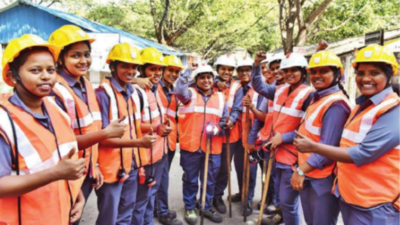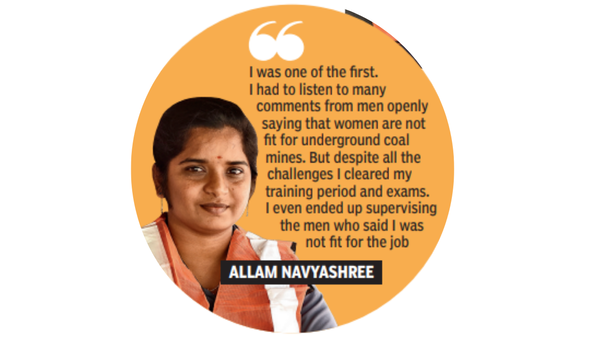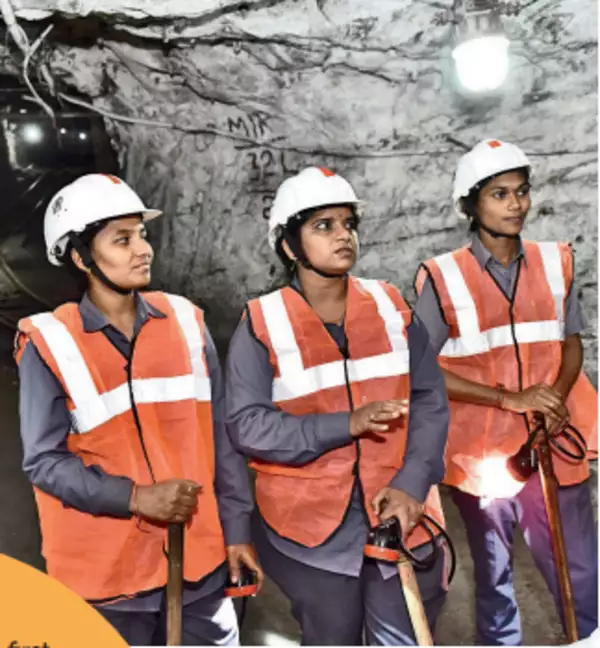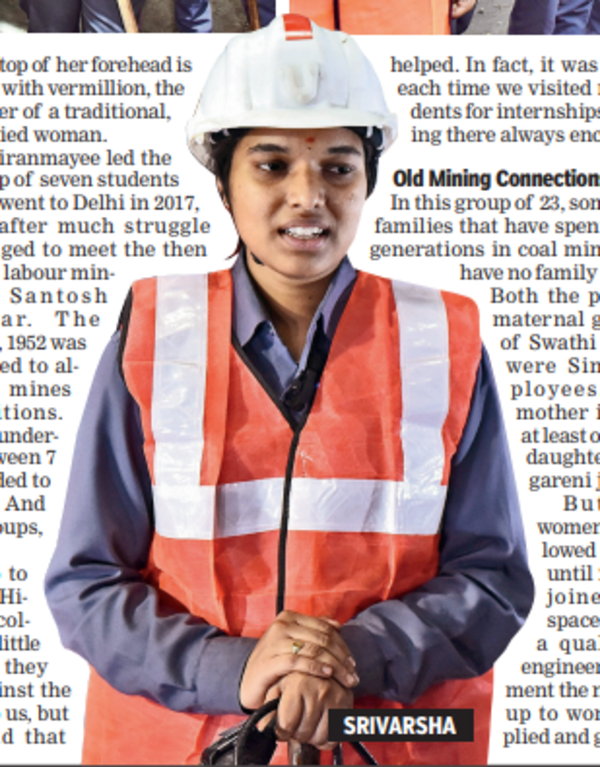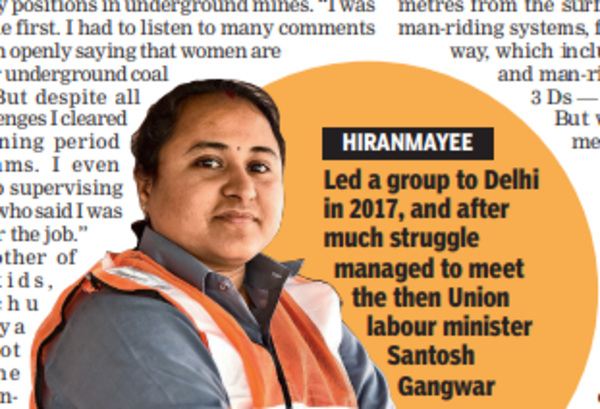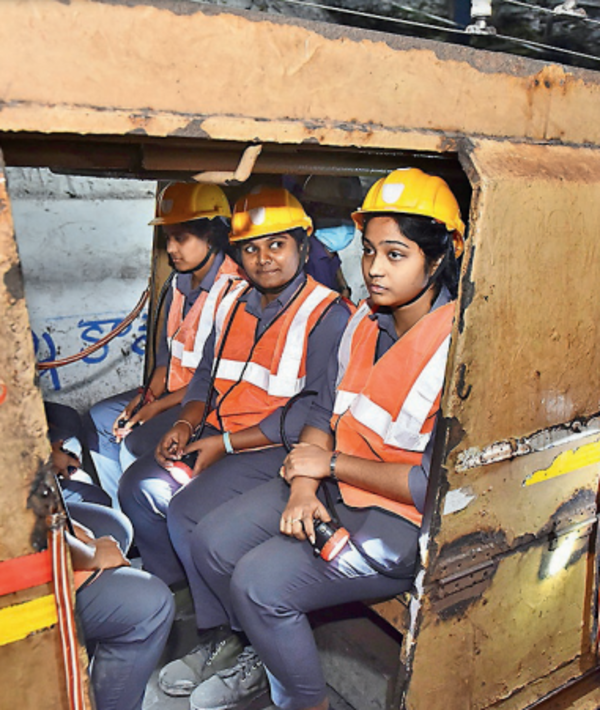Women’s deep dive into this 3D world
Dark, Dirty and Dangerous — that’s the 3D world of mines for you. Women were banned from underground mines, till seven women students petitioned the central govt to lift it. The ban went in 2019. Singareni Collieries in Telangana, one of the oldest coal mining PSUs, started recruiting women miners in 2023. Robin David and Koride Mahesh visited Singareni’s 11 Incline mine to find how women are chipping away at what was till recently only a man’s universe
Some very basic coal mining terms start with the word ‘man’. Manway, man-riding, mantrip… But managers (all of them men) of the 11 Incline mine of
Singareni
Collieries Ltd, one of the oldest coal mining PSUs in the country, feel it is about time ‘man’ is replaced with ‘person’. That’s because Singareni Collieries has become the first PSU in the country to allow women into underground mines. It has decided to dedicate one mine each — underground and opencast — to women.
The central govt changed the law, allowing women in underground mines, in 2019, 82 years after the British govt first banned their entry. The 1937 ban sought to protect women from what was seen as an inhuman and oppressive working environment, not suited for women. The ban was lifted in 1943 but was back again in 1946.
TOI visited Telangana’s Ramagundam coal mine areas in Peddapalli district recently where the 11 Incline mine is also located. There are 23 women miners there. They don’t exude toughness. It’s hard to picture them inside a mine. But the moment they start putting on their gear to travel almost 2 km underground — heavy-duty boots, sturdy helmets, workman’s overalls and headlights — you realise they are pros. Unlike the all-male TOI team, which struggled with the gear.
Dark, Narrow, Stifling
The atmosphere in a coal mine, especially for someone not used to those narrow confines, can be stifling. There is obviously no natural light, the space is narrow and everything you say echoes. A man-riding train takes you down.
But the women seem at home in this dark universe. They fit into it as if it was their natural domain.
The Woman Who Challenged Ban
Among the women is
Neredukomma Hiranmayee
. If the central govt decided to amend the Coal Mining Act and allow women into underground coal mines it was largely because of this unrelenting lady who decided to challenge the laws of the land.
“Seven women students, including me, were about to graduate from a mining college not far from here when we saw an ad by Singareni looking for engineers, but it said only men could apply,” Hiranmayee says. “This was very disheartening. We decided to go to Delhi and talk to the central govt about allowing us to do the work we were trained for. Allowing women to study mining and then not letting them work in mines — we were not ready to accept that.”
Women’s deep dive into this 3D world
The top of her forehead is dotted with vermillion, the marker of a traditional, married woman.
Hiranmayee led the group of seven students who went to Delhi in 2017, and after much struggle managed to meet the then Union labour minister Santosh Gangwar. The Mines Act, 1952 was then amended to allow women in mines with some conditions. Women were to work in underground mines only between 7 am and 6 pm. They needed to give a written consent. And they had to work in groups, always.
“The decision to go to Delhi was a tough one,” Hiranmayee adds. “Our college management was a little upset with us because they felt we were going against the govt and refused to help us, but we were adamant and that helped. In fact, it was strange that each time we visited mines as students for internships, those working there always encouraged us.
Women’s deep dive into this 3D world
Old Mining Connections
In this group of 23, some come from families that have spent a couple of generations in coal mines and some have no family connections.
Both the paternal and maternal grandfathers of Swathi Penugonada were Singareni employees. Swathi’s mother insisted that at least one of her two daughters got a Singareni job.
Women’s deep dive into this 3D world
But because women were not allowed in coal mines until 2019, she had joined an aerospace company as a quality control engineer. But the moment the mines opened up to women, she applied and got in. “I have worked very hard to be here and I feel proud that I am living my mother’s dream,” she says.
Swathi adds that there was a lot of pressure from her extended family to get married, but because her mother stood by her, she was able to push back and become a miner.
Supervising Men
Allam Navyashree is a 2019 mining engineering graduate. “I got a job with a private firm first, working in underground mines as a section supervisor.” She says at the time there were no women in supervisory positions in underground mines. “I was one of the first. I had to listen to many comments from men openly saying that women are not fit for underground coal mines. But despite all the challenges I cleared my training period and exams. I even ended up supervising the men who said I was not fit for the job.”
Women’s deep dive into this 3D world
A mother of two kids, Chunchu Sandhya Rani, got into the mining en gineer job after her marriage. “When I got married in my final year of the mining engineering course from Jawaharlal Nehru Technical University (JNTU), Manthani, I thought my working life was over. But my husband, in-laws and my father encouraged me to apply for the job at Singareni mines. Now, my parents look after my two kids when I come to the mines,” Sandhya says.
For Neeli Jyothsna, a diploma holder in ITI electric and now a trainee, her goal was only to land a govt job as none of her family was a govt employee. Her father, a private teacher, tried for a govt job but failed. Now, she has fulfilled her father’s dream.
Thorrikonda Srivarsha continued the family tradition of landing jobs at Singareni. Both her grandfathers — her mother’s father and father’s father — were Sinagareni workers. Her mother wants the legacy to continue.
Chilka Srinivas, deputy general manager and project officer at 11 Incline, says Singareni Collieries has been at the forefront in giving “equality below ground”. As of now, 16 types of designations and jobs have been identified for women, both in underground and opencast mines.
Women’s deep dive into this 3D world
450 Metres Below Ground
Singareni Collieries’ Ramagundam Area-1 general manager Lalit Kumar D says women employees and workers now work at a depth of about 450 metres from the surface, travelling along three man-riding systems, for a distance of 4.5 km one way, which includes mechanised transport and man-ridings. “Mining is all about 3 Ds — dark, dirty and dangerous. But women work on a par with men,” Kumar adds.
The GM says Singareni Collieries is providing equal opportunities for women and ensuring their safety. There’s a separate transport facility for women, first-aid rooms with female nurses, washrooms and creche. And everyone’s being trained on gender sensitivity.


